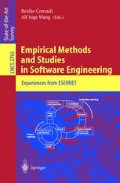Abstract
This chapter discusses the experimental comparison of two reading techniques, comparing their effectiveness and detection rates with respect to inspecting high-level UML diagrams for defects. Artifact-related checklists drive one technique, and application use cases drive the other. Our initial idea was that the latter is more effective than the former. This experiment was developed at the University of Rome “Tor Vergata”. It was conducted with junior and senior students of object-oriented analysis and design in the university’s Department of Informatics, Systems and Production. The data collected shows that techniques performed differently. Specifically, for effectiveness, CBR in the average performed + 41.6% better than UCDR. CBR detected 15.6% more seeded defects, and +149.3% more new faults, than UCDR. The latter provided 11.6% less false positives than CBR. For detection rate, the checklist-based reading technique’s peak value occurred 25% later, and was 66.7% greater, than the use-case driven reading’s peak value. However, the results were not statistically significant. Because the use-case-driven script turned out to be much more complex than the checklist-driven one, we decided to restructure the former in multiple layers and hence conducted further experiments, the results of which are forthcoming.
Access this chapter
Tax calculation will be finalised at checkout
Purchases are for personal use only
Preview
Unable to display preview. Download preview PDF.
References
Laitenberger, O.: Perspective-Based Reading: Technique, Validation and Research in Future. University of Kaiserslautern, Germany (1995) ISERN-95-01
Booch, G., Rumbaugh, J., Jacobson, I.: Unified Modeling Language. User Guide. Addison-Wesley, Reading (1999)
Booch, G.: Object-oriented analysis and design. Benjamin/Cummings P. C. Inc. (1994)
Kruchten, P.: Rational Unified Process. Introduzione. Addison-Wesley Longman, Italy (1999)
Basili, V.R., Green, S., Laitenberger, O., Lanubile, F., Shull, F., Sorumgard, S., Zelkowitz, M.V.: The Empirical Investigation of Perspective-Based Reading. University of Maryland, USA (1996) ISERN-96-06
Ciolkowski, M., Differding, C., Laitenberger, O., Münch, J.: Empirical Investigation of Perspective-Based Reading: A Replicated Experiment. Fraunhofer Institute for Experimental Software Engineering, Germany (1997) ISERN-97-13
Laitenberger, O., DeBaud, J.-M.: Perspective-Based Reading of Code Documents at Robert Bosch GmbH. Fraunhofer Institute for Experimental Software Engineering, Germany (1997) ISERN-97-14
UMDCS ESEG. Lab Package for the Empirical Investigation of Perspective-Based Reading, www.cs.umd.edu/projects/SoftEng/ESEG/manual/pbr_package/manual.html , 18.03.2003
Laitenberger, O., El Emam, K., Harbich, T.: An Internally Replicated Quasi-Experimental Comparison of Checklist and Perspective-Based Reading of Code Documents. Fraunhofer Institute for Experimental Software Engineering, Germany (1999) ISERN-99-01
Shull, F., Lanubile, F., Basili, V.R.: Investigating Reading Techniques for Framework Learning. University of Maryland, USA (1998) ISERN-98-16
Lanubile, F., Visaggio, G.: Evaluating Defect Detection Techniques for Software Requirements Inspections. University of Bari, Italy (2000) ISERN-00-08
Laitenberger, O., Atkinson, C., Schlich, M., El Emam, K.: Reading Techniques for Defect Detection in UML Design Documents. Fraunhofer Institute for Experimental Software Engineering, Germany (2000) ISERN-00-01
Travassos, G.H., Shull, F., Carver, J.: Working with UML: A Software Design Process Based on Inspections for UML. Advances in Computers 54, 35–98 (2001)
Cantone, G., Colasanti, L., Calavaro, G.: Evaluating Checklist-Based and Use-Case-Driven Reading Technique of Software Analysis and Design UML Artifacts. Preliminary results from multi-replicated experiments with students of different level of experience. In: Proceedings of 2002 International Symposium on Empirical Software Engineering, IEEE ISESE, vol. II—Poster and Demonstration Sessions, Nara, Japan, 3–4 October, pp. 7–8 (2002)
Pfleeger, S.L.: Software engineering: Theory and Practice, 2nd edn. Prentice Hall, Englewood Cliffs (2002)
IBM Corp. S/390 Orthogonal Defect Classification Education, www-1.ibm.com/servers/eserver/zseries/odc/nonshock/odc8ns.html 4.04.2003
Cantone, G., Celiberti, S.: Evaluating efficiency, effectiveness and other indices of code reading and functional testing for concurrent event-driven Java software. Results from a multi-replicated experiment with students of different level of experience. In: Proceedings of 2002 ISESE, Poster and Research Demonstration Sessions, Nara, Japan, October 3-4, Vol. II, pp. 23–24 (2002)
Cantone, G., Abdulnabi, Z.A., Lomartire, A., Calavaro, G.: Evaluating efficiency and effectiveness of code reading and functional testing for concurrent event-driven Java software: Preliminary results from a multi-replicated experiment with students of different level of experience (2003) (see Chapter 10 in this book)
Wohlin, C., Runeson, P., Horst, M., Ohlsson, M.C., Regnell, B., Wesslén, A.: Experimentation in Software Engineering. An Introduction. Kluwer A. P., Dordrecht (2000)
Laitenberger, O., DeBaud, J.-M.: An encompassing life cycle centric survey of software inspection. The Journal of Systems and Software 50(1), 5–31 (2000)
Gilb, T., Graham, D.: Software Inspection. Addison-Wesley, Reading (1993)
Chernak, Y.: A Statistical Approach to the Inspection Checklist Formal Synthesis and Improvement. IEEE Transactions on Software Engineering 22(12), 866–874 (1996)
Macdonald, F., Miller, J.: A Comparison of Tool-Based and Paper-Based Software Inspection. University of Strathclyde, UK (1998) ISERN-98-17
Author information
Authors and Affiliations
Editor information
Editors and Affiliations
Rights and permissions
Copyright information
© 2003 Springer-Verlag Berlin Heidelberg
About this chapter
Cite this chapter
Cantone, G., Colasanti, L., Abdulnabi, Z.A., Lomartire, A., Calavaro, G. (2003). Evaluating Checklist-Based and Use-Case-Driven Reading Techniques as Applied to Software Analysis and Design UML Artifacts. In: Conradi, R., Wang, A.I. (eds) Empirical Methods and Studies in Software Engineering. Lecture Notes in Computer Science, vol 2765. Springer, Berlin, Heidelberg. https://doi.org/10.1007/978-3-540-45143-3_9
Download citation
DOI: https://doi.org/10.1007/978-3-540-45143-3_9
Publisher Name: Springer, Berlin, Heidelberg
Print ISBN: 978-3-540-40672-3
Online ISBN: 978-3-540-45143-3
eBook Packages: Springer Book Archive

